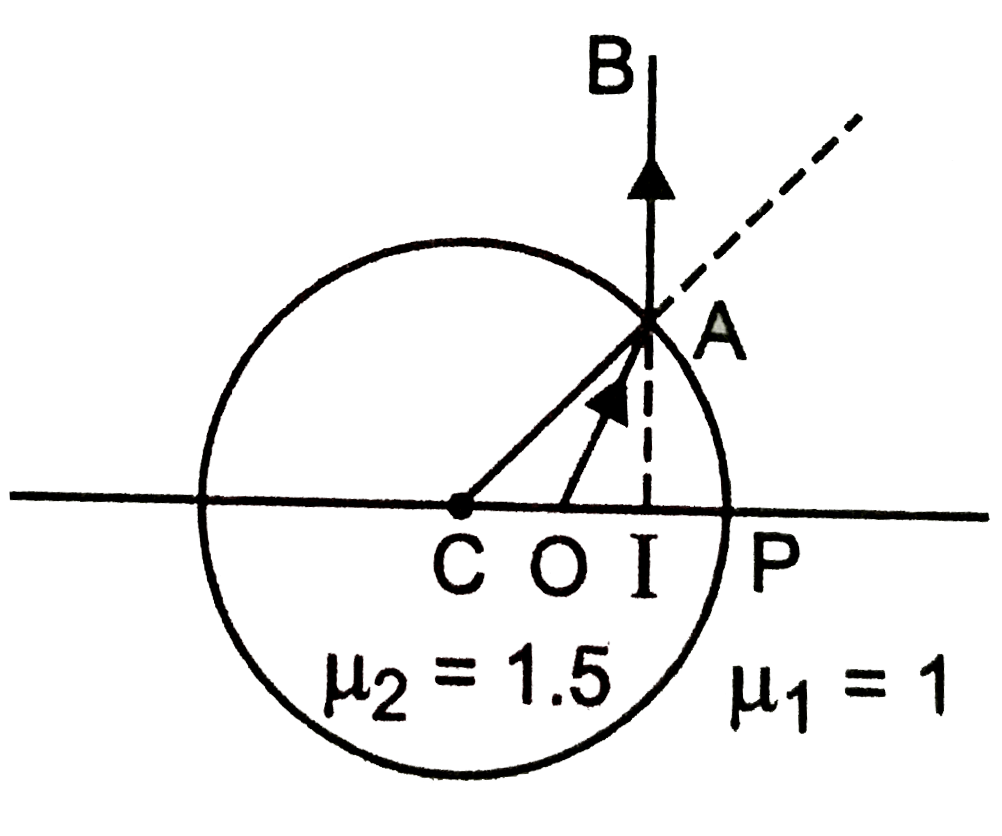A point 'O' marked on the surface of a glass sphere of diameter 20 cm is viewed through glass from the position directly opposite to the point O. If the refractive index of the glass is 1.5, find the position of the image formed. Also, draw the ray diagram for the formation of the image.

As per question here u = OP = 20 cm and u is - ve. Radius of curvature
of glass sphere R=PC=202=10cm and R is also negative, refractive index of glass, nx = 1.5.
Since object O is marked on the surface of glass sphere and is seen from directly opposite position, the point P acts as pole and refraction takes place from glass to air i.e., glass is medium number 1 and air is medium number 2. So,

n2v−n1u=n2−n1R
⇒1v=0.510−1.520⇒v=−40cm
Thus, image / is 40 cm behind pole P or 20 cm behind the mark O. The ray diagram 9.60 is shown above.
Topper's Solved these Questions
- RAY OPTICS AND OPTICAL INSTRUMENTSBook:U-LIKE SERIESChapter:RAY OPTICS AND OPTICAL INSTRUMENTSExercise:LONG ANSWER QUESTIONS-II
Explore 9 Videos
- RAY OPTICS AND OPTICAL INSTRUMENTSBook:U-LIKE SERIESChapter:RAY OPTICS AND OPTICAL INSTRUMENTSExercise:SELF ASSESSMENT TEST (SECTION A)(MULTIPLE CHOICE QUESTIONS)
Explore 5 Videos
- RAY OPTICS AND OPTICAL INSTRUMENTSBook:U-LIKE SERIESChapter:RAY OPTICS AND OPTICAL INSTRUMENTSExercise:SHORT ANSWER QUESTIONS
Explore 54 Videos
- NUCLEIBook:U-LIKE SERIESChapter:NUCLEIExercise:Self Assessment Test
Explore 10 Videos
- SEMICONDUCTOR ELECTRONICS : MATERIALS, DEVICES AND SIMPLE CIRCUITSBook:U-LIKE SERIESChapter:SEMICONDUCTOR ELECTRONICS : MATERIALS, DEVICES AND SIMPLE CIRCUITSExercise:SECTION B
Explore 1 Video
Similar Questions
A mark placed on the surface of a sphere is viewed through glass from a position directly opposite. If the diameter of the sphere is 10cm and refractive index of glass is 1.5, find the position of the image.
View SolutionA mark placed on the surface of glass sphere is viewed through glass from an oppositely directed position. If the diameter of the sphere is 30 cm, locate the image of the mark. For glass, μ=1.5

View Solution
Knowledge Check
A mark placed on the surface of a sphere is viewed through glass from a position directly opposite. If the diameter of the sphere is 10cm and refractive index of glass is 1.5, find the position of the image.
A−20cmB30cmC40cmD−10cmA mark is made on the surface of a glass sphere of diameter 10 cm and refractive index 1.5. It is viewed through the glass from a portion directly opposite. The distance of the image of the mark from the centre of the sphere will be
A15 cmB17.5 cmC20 cmD22.5 cmAn air bubble in sphere having 4cm diameter appears of 1 cm from surface nearest to eye when looked along diameter. If nga = 1.5, the distance of bubble from refracting surface is
A1.2 cmB3.2 cmC2.8 cmD1.6 cm
A small air bubble in a glass sphere of radius 2cm appears to be 1cm from the surface when looked at, along a diameter. If the refractive index of glass is 1.5, find the true position of the air bubble.
 .
.
View SolutionIf a mark of size 0.2 cm on the surface of a glass sphere of diameter 10 cm and μ=1.5is viewed through the diametrically opposite point, where will the image be seen and of what size? (in mm)
View SolutionAn object is at a distance of d=2.5cm from the surface of a glass sphere with a radius R=10cm. Find the position of the final image produced by the sphere. The refractive index of glass is μ1.5.
View SolutionAn object is at a distance of d=2.5cm from the surface of a glass sphere with a radius R=10cm. Find the position of the final image produced by the sphere. The refractive index of glass is μ=1.5.
View SolutionA small object stuck on the surface of a glass sphere (n=1.5) is viewed from the diametrically opposite position. Find transverse magnification.
View Solution
